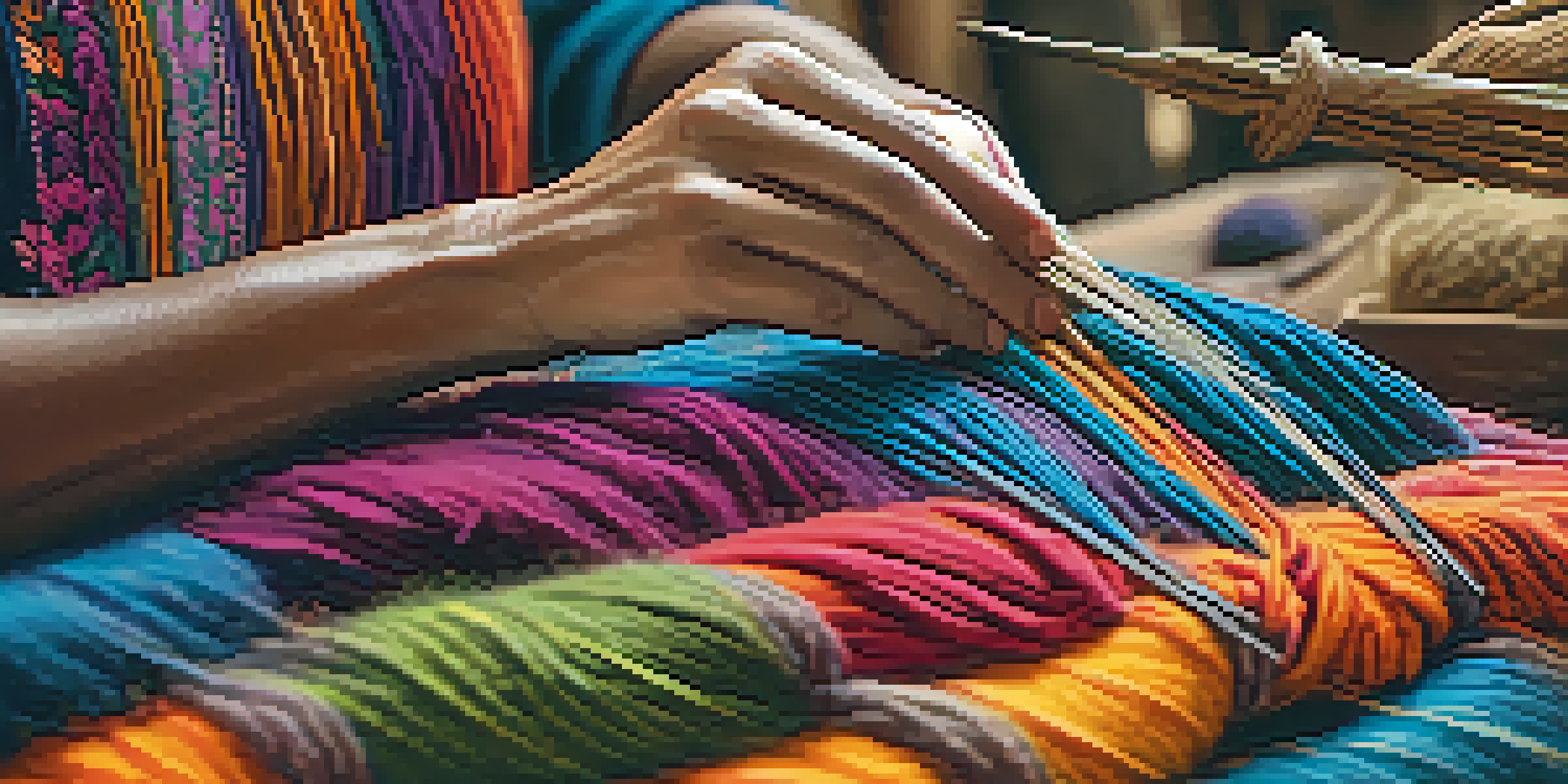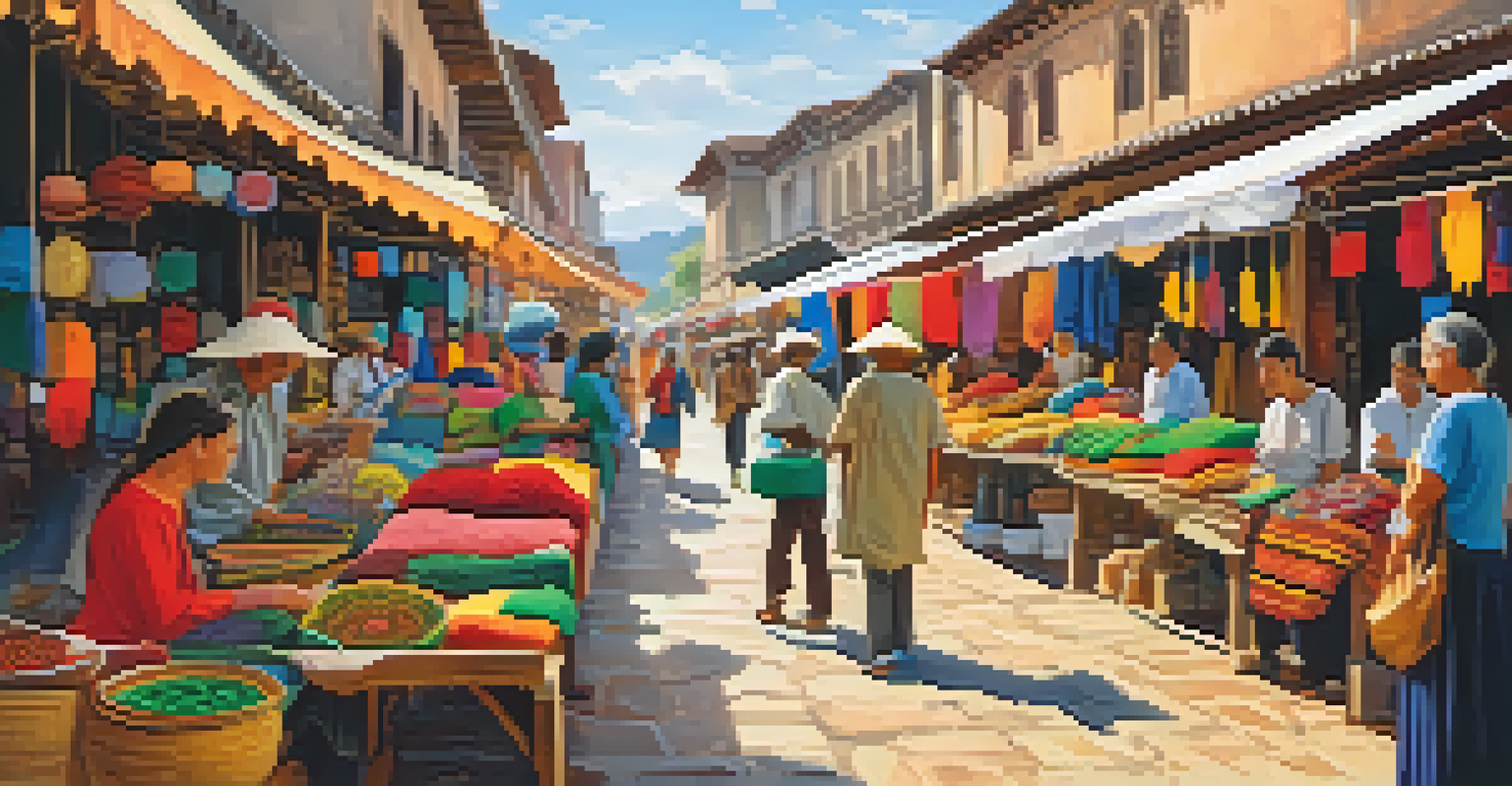Sustainable Practices in Peruvian Craftsmanship and Art

The Rich Heritage of Peruvian Craftsmanship
Peru boasts a vibrant tradition of craftsmanship, steeped in history and culture. From textiles to ceramics, each craft reflects the region's rich heritage and the skills passed down through generations. Artisans often draw inspiration from their surroundings, creating pieces that celebrate their identity and environment.
Craftsmanship is not just about making things; it's about building a connection to culture and sustainability.
This deep-rooted connection to the land has fostered an appreciation for sustainable practices. Many artisans use locally sourced materials, ensuring their crafts support the local economy and minimize environmental impact. For example, natural dyes derived from plants are commonly used in textiles, reducing reliance on synthetic options.
As global awareness of sustainability increases, Peruvian artisans are finding new ways to merge tradition with modern eco-friendly practices. This blend not only preserves their cultural identity but also aligns with the values of conscious consumers seeking responsible art and craftsmanship.
Sustainable Material Sourcing in Artisanal Work
One of the key aspects of sustainable craftsmanship in Peru is the careful sourcing of materials. Many artisans prioritize renewable and biodegradable resources, such as alpaca wool, which is both luxurious and sustainable. This approach not only respects the environment but also highlights the unique qualities of local materials.

Additionally, some craftspeople are reviving ancient techniques that utilize discarded or natural materials. For instance, the practice of using repurposed textiles allows artisans to create stunning new pieces while reducing waste. This innovative thinking not only helps the planet but also adds an element of creativity and uniqueness to their work.
Craftsmanship Reflects Cultural Heritage
Peruvian artisans create unique crafts that celebrate their identity and heritage, using traditional techniques passed down through generations.
By embracing sustainable material sourcing, Peruvian artisans not only contribute to environmental preservation but also tell a story through their creations. Each item becomes a testament to their commitment to the planet, offering consumers a tangible connection to the values of sustainability.
The Role of Cultural Identity in Sustainable Practices
Cultural identity plays a significant role in how Peruvian artisans approach sustainability. Many crafts are deeply intertwined with the beliefs and practices of local communities, making sustainability a natural extension of their cultural values. This connection fosters a sense of responsibility towards their environment and traditions.
The beauty of handcrafted items lies in their story, a narrative that reflects the heart and soul of the artisan.
Artisans often share their stories through their work, using traditional motifs and techniques that reflect their heritage. This storytelling aspect not only preserves cultural history but also promotes awareness of sustainable practices. Consumers are drawn to these narratives, finding value in the ethical choices behind each piece.
As these artisans continue to uphold their cultural identity, they inspire others to appreciate the importance of sustainable practices. This cultural exchange enriches the global conversation about craftsmanship and encourages a more conscious approach to art.
Impact of Tourism on Sustainable Craftsmanship
Tourism has a profound influence on Peruvian craftsmanship, often serving as a double-edged sword. While it provides a vital source of income for artisans, it can also lead to exploitation and the commercialization of traditional crafts. However, an increasing number of tourists are seeking authentic experiences, driving demand for sustainable products.
Many artisans have embraced this shift by creating eco-friendly souvenirs that reflect their commitment to sustainability. This not only caters to the values of mindful travelers but also helps preserve traditional techniques and materials. For instance, a tour that includes workshops with local artisans can foster appreciation for their craftsmanship and sustainable practices.
Sustainability Drives Artisanal Practices
Many Peruvian artisans prioritize sustainable material sourcing, using locally sourced and biodegradable resources to minimize environmental impact.
By focusing on sustainability, artisans can attract responsible tourism that benefits both the economy and the environment. This harmonious relationship encourages visitors to engage with local culture while supporting practices that honor the planet.
Collaboration and Community in Sustainable Art
Collaboration is a cornerstone of sustainable craftsmanship in Peru. Many artisans work together in cooperatives, pooling resources and skills to enhance their craft. This community approach not only strengthens their craft but also creates a supportive network that prioritizes sustainable practices.
By sharing knowledge and techniques, artisans can innovate while staying true to their roots. For example, a cooperative might explore new methods of natural dyeing, combining traditional practices with modern understanding of sustainability. This blend of old and new fosters creativity and ensures the longevity of their art.
This spirit of collaboration extends beyond local artisans, as many are now connecting with global initiatives focused on sustainability. By participating in international fairs or online platforms, they can showcase their work and raise awareness about the importance of sustainable practices in craftsmanship.
Challenges Facing Sustainable Practices in Craftsmanship
Despite the positive strides made in sustainable craftsmanship, challenges remain for Peruvian artisans. Economic pressures can lead to compromises in sustainability, with some artisans opting for cheaper, less eco-friendly materials to remain competitive. This dilemma highlights the need for ongoing support and education in sustainable practices.
Additionally, the demand for mass-produced goods can overshadow the value of handcrafted items. Consumers often prioritize cost over sustainability, which risks undermining the livelihoods of artisans committed to ethical practices. Raising awareness about the importance of supporting sustainable craftsmanship is crucial for their survival.
Tourism Fuels Sustainable Craft Demand
The rise in eco-conscious tourism has led artisans to create authentic, eco-friendly products that attract responsible travelers while preserving traditional methods.
Addressing these challenges requires a collective effort from consumers, artisans, and organizations. By fostering a culture of appreciation for sustainable crafts, we can help ensure that these valuable practices continue to thrive in Peru and beyond.
The Future of Sustainable Craftsmanship in Peru
Looking ahead, the future of sustainable craftsmanship in Peru appears promising. As more artisans embrace eco-friendly practices, there is a growing interest from consumers in sustainable products. This shift can lead to a revival of traditional techniques, ensuring their preservation for future generations.
Educational programs and workshops are emerging, empowering artisans with knowledge about sustainability and market trends. These initiatives help them navigate the challenges they face while enhancing their skills and creativity. By investing in their education, the artisan community can continue to innovate and adapt.

Ultimately, the future of sustainable craftsmanship in Peru depends on a global commitment to supporting small artisans. By choosing to invest in their work, consumers can play a pivotal role in promoting sustainability and respecting the rich cultural heritage that defines Peruvian craftsmanship.